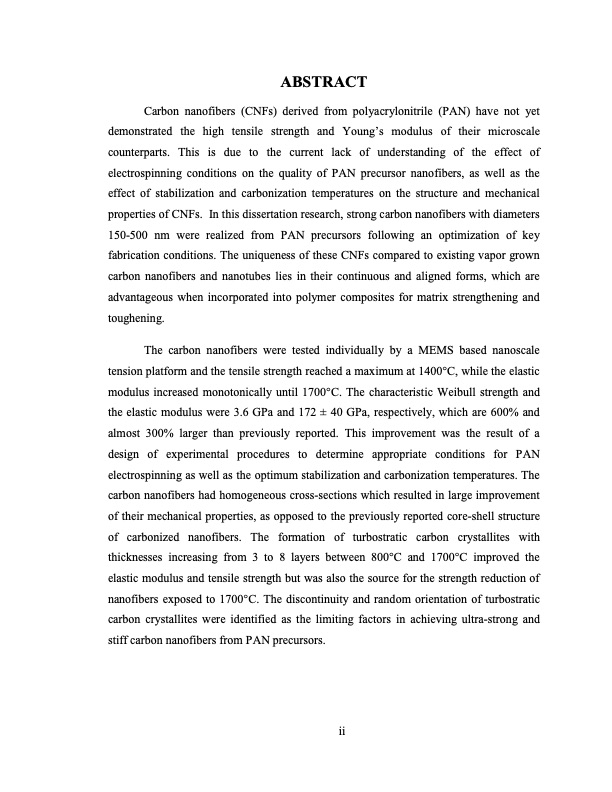
PDF Publication Title:
Text from PDF Page: 002
ABSTRACT Carbon nanofibers (CNFs) derived from polyacrylonitrile (PAN) have not yet demonstrated the high tensile strength and Young’s modulus of their microscale counterparts. This is due to the current lack of understanding of the effect of electrospinning conditions on the quality of PAN precursor nanofibers, as well as the effect of stabilization and carbonization temperatures on the structure and mechanical properties of CNFs. In this dissertation research, strong carbon nanofibers with diameters 150-500 nm were realized from PAN precursors following an optimization of key fabrication conditions. The uniqueness of these CNFs compared to existing vapor grown carbon nanofibers and nanotubes lies in their continuous and aligned forms, which are advantageous when incorporated into polymer composites for matrix strengthening and toughening. The carbon nanofibers were tested individually by a MEMS based nanoscale tension platform and the tensile strength reached a maximum at 1400°C, while the elastic modulus increased monotonically until 1700°C. The characteristic Weibull strength and the elastic modulus were 3.6 GPa and 172 ± 40 GPa, respectively, which are 600% and almost 300% larger than previously reported. This improvement was the result of a design of experimental procedures to determine appropriate conditions for PAN electrospinning as well as the optimum stabilization and carbonization temperatures. The carbon nanofibers had homogeneous cross-sections which resulted in large improvement of their mechanical properties, as opposed to the previously reported core-shell structure of carbonized nanofibers. The formation of turbostratic carbon crystallites with thicknesses increasing from 3 to 8 layers between 800°C and 1700°C improved the elastic modulus and tensile strength but was also the source for the strength reduction of nanofibers exposed to 1700°C. The discontinuity and random orientation of turbostratic carbon crystallites were identified as the limiting factors in achieving ultra-strong and stiff carbon nanofibers from PAN precursors. iiPDF Image | HIGH STRENGTH CARBON NANOFIBERS DERIVED FROM ELECTROSPUN POLYACRYLONITRILE

PDF Search Title:
HIGH STRENGTH CARBON NANOFIBERS DERIVED FROM ELECTROSPUN POLYACRYLONITRILEOriginal File Name Searched:
4835609.pdfDIY PDF Search: Google It | Yahoo | Bing
Sulfur Deposition on Carbon Nanofibers using Supercritical CO2 Sulfur Deposition on Carbon Nanofibers using Supercritical CO2. Gamma sulfur also known as mother of pearl sulfur and nacreous sulfur... More Info
CO2 Organic Rankine Cycle Experimenter Platform The supercritical CO2 phase change system is both a heat pump and organic rankine cycle which can be used for those purposes and as a supercritical extractor for advanced subcritical and supercritical extraction technology. Uses include producing nanoparticles, precious metal CO2 extraction, lithium battery recycling, and other applications... More Info
| CONTACT TEL: 608-238-6001 Email: greg@infinityturbine.com | RSS | AMP |